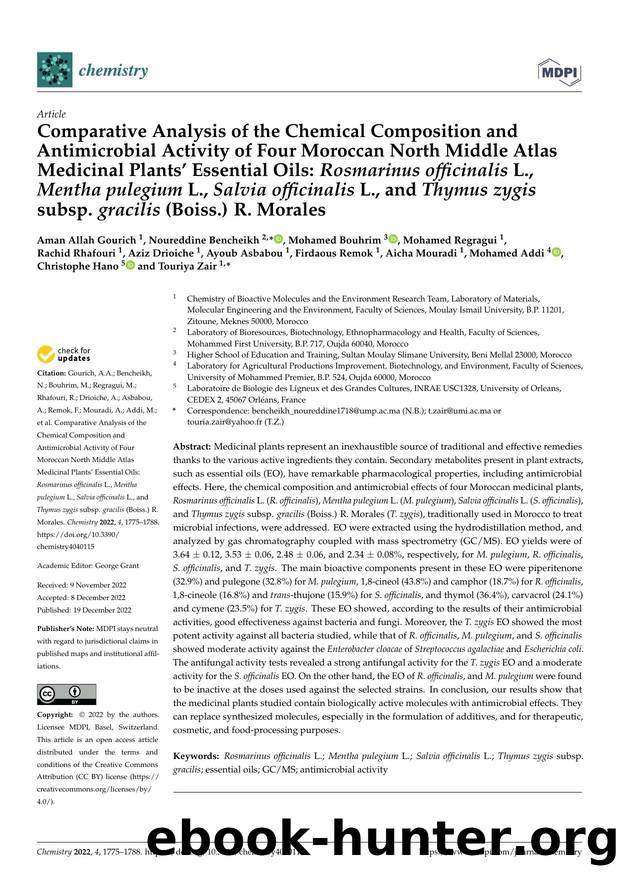Comparative Analysis of the Chemical Composition and Antimicrobial Activity of Four Moroccan North Middle Atlas Medicinal Plantsâ Essential Oils: Rosmarinus officinalis L., Menth by unknow

Author:unknow
Format: pdf
Tags: Medicinal plants represent an inexhaustible source of traditional and effective remedies thanks to the various active ingredients they contain. Secondary metabolites present in plant extracts, such as essential oils (EO), have remarkable pharmacological properties, including antimicrobial effects. Here, the chemical composition and antimicrobial effects of four Moroccan medicinal plants, Rosmarinus officinalis L. (R. officinalis), Mentha pulegium L. (M. pulegium), Salvia officinalis L. (S. officinalis), and Thymus zygis subsp. gracilis (Boiss.) R. Morales (T. zygis), traditionally used in Morocco to treat microbial infections, were addressed. EO were extracted using the hydrodistillation method, and analyzed by gas chromatography coupled with mass spectrometry (GC/MS). EO yields were of 3.64 0.12, 3.53 0.06, 2.48 0.06, and 2.34 0.08%, respectively, for M. pulegium, R. officinalis, S. officinalis, and T. zygis. The main bioactive components present in these EO were piperitenone (32.9%) and pulegone (32.8%) for M. pulegium, 1,8-cineol (43.8%) and camphor (18.7%) for R. officinalis, 1,8-cineole (16.8%) and trans-thujone (15.9%) for S. officinalis, and thymol (36.4%), carvacrol (24.1%) and cymene (23.5%) for T. zygis. These EO showed, according to the results of their antimicrobial activities, good effectiveness against bacteria and fungi. Moreover, the T. zygis EO showed the most potent activity against all bacteria studied, while that of R. officinalis, M. pulegium, and S. officinalis showed moderate activity against the Enterobacter cloacae of Streptococcus agalactiae and Escherichia coli. The antifungal activity tests revealed a strong antifungal activity for the T. zygis EO and a moderate activity for the S. officinalis EO. On the other hand, the EO of R. officinalis, and M. pulegium were found to be inactive at the doses used against the selected strains. In conclusion, our results show that the medicinal plants studied contain biologically active molecules with antimicrobial effects. They can replace synthesized molecules, especially in the formulation of additives, and for therapeutic, cosmetic, and food-processing purposes., Rosmarinus officinalis L.; Mentha pulegium L.; Salvia officinalis L.; Thymus zygis subsp. gracilis; essential oils; GC/MS; antimicrobial activity
Download
This site does not store any files on its server. We only index and link to content provided by other sites. Please contact the content providers to delete copyright contents if any and email us, we'll remove relevant links or contents immediately.
Alchemy and Alchemists by C. J. S. Thompson(3451)
The Elements by Theodore Gray(2998)
The Club by A.L. Brooks(2862)
How to Make Your Own Soap by Sally Hornsey(2829)
Drugs Unlimited by Mike Power(2545)
Wheels of Life by Anodea Judith(2098)
Cracking the LSAT, 2012 Edition by Princeton Review(1883)
Cracking the Sat French Subject Test, 2013-2014 Edition by The Princeton Review(1829)
Perfume by Jean-Claude Ellena(1782)
The Flavor Matrix by James Briscione(1775)
The Cosmic Machine: The Science That Runs Our Universe and the Story Behind It by Scott Bembenek(1726)
Quantitative and Pattern Recognition Analyses of Five Marker Compounds in Raphani Semen using High-Performance Liquid Chromatography by Unknown(1701)
MCAT Physics and Math Review by Princeton Review(1637)
1000 Multiple-Choice Questions in Organic Chemistry by Organic Chemistry Academy(1621)
The Thing Around Your Neck by Chimamanda Ngozi Adichie(1600)
Handbook of Modern Sensors by Jacob Fraden(1544)
Cracking the SAT Premium Edition with 6 Practice Tests, 2017 by Princeton Review(1539)
Synchrotron Light Sources and Free-Electron Lasers by Eberhard J. Jaeschke Shaukat Khan Jochen R. Schneider & Jerome B. Hastings(1524)
A is for Arsenic: The Poisons of Agatha Christie (Bloomsbury Sigma) by Kathryn Harkup(1507)
